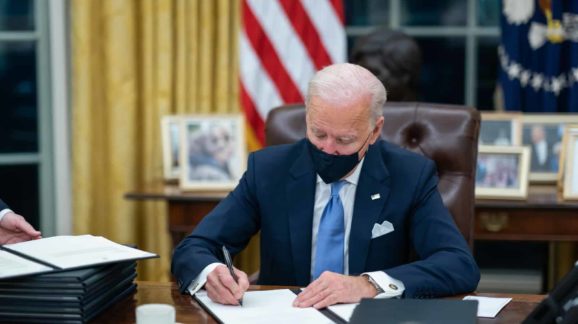Biden’s ‘Infrastructure’ Plan: If You Build It, You Will Pay
Redefining ‘infrastructure’ doesn’t make Biden’s bill any less wasteful.
You and I come by road or rail. Economists travel on infrastructure,” Margaret Thatcher once told an audience — pillorying economists’ love of jargon and recognizing the real value of infrastructure in allowing people to go about their daily business. President Biden’s infrastructure plan is bloated, wasteful, and indifferent to how people really travel. It could do with a good dose of Thatcherite logic.
First, there’s the bloat. The bill can be seen as the second part (with the American Relief Act being the first) of a partisan wish list of items, this time being sold as “infrastructure.”
Much has already been made of this. Senator Kirsten Gillibrand’s Humpty Dumpty–like attempt to redefine the term to fit the bill was widely criticized on social media. A Politico review of the bill’s $2.25 trillion spending plans found that $821 billion would count as infrastructure under generally accepted definitions and $111 billion was probably close enough to count. However, $1.32 trillion, or close to 60 percent of the bill’s total tab, was “really stretching things,” “a very distant relative of,” or “not even remotely” infrastructure.
Given the bipartisan agreement that genuine infrastructure needs attention (even recognizing that the nation’s infrastructure isn’t in as bad shape as it is painted), the president probably could move a bill with broad cross-party support. The decision to attach sundry unrelated items — such as federal funding of schools, job-training initiatives, and unionization of home health-care and child-care workers — to what most voters consider a must-pass bill suggests that Biden doesn’t think he can get those passed any other way.
Then there’s the cost. President Biden boastfully claimed that the bill would create 19 million jobs “that pay well.” That could possibly represent value for money at $118,000 a job. However, Transportation Secretary Pete Buttigieg had to contradict his boss, recognizing that this figure included over 16 million jobs that would be created anyway. As Reason’s Eric Boehm calculated, that puts the dollar figure per job created at over $800,000. It’s not quite the $2 million per job created by Los Angeles after the Obama stimulus act, but it’s getting there, and on a much bigger scale.
Part of the reason is that the bill doesn’t help make the building of real infrastructure projects quicker or more affordable. In fact, it doubles down on policies such as project labor agreements and “Buy American” requirements, while failing to do anything about the plague of permits. Perhaps the president’s old boss could remind him how those affected his stimulus bill’s supposedly shovel-ready projects.
Finally, there’s the waste. Perhaps the worst aspect of the bill is that it misunderstands what people need from infrastructure. Simply throwing money around and building projects is a spectacularly bad way to build the road and (sometimes) rail they need.
Read the full article at National Review.
